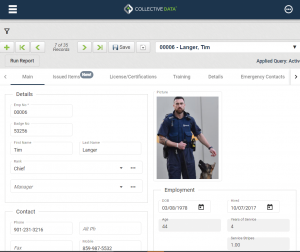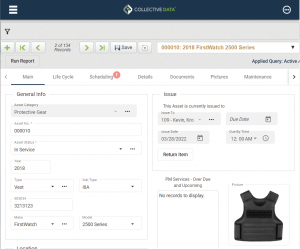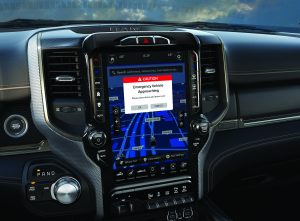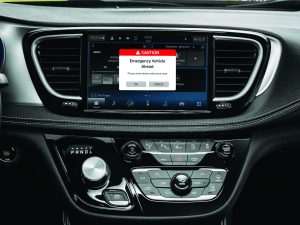For several years, addressing traffic safety issues across the globe has been a top priority for the IACP.
According to Un-jamming Traffic: Driving Toward Safer, Quicker Clearance of Traffic Incidents, “In 2019, 44 responders [specifically] 18 law enforcement officers, 9 fire/EMS responders, 14 tow operators, and three mobile mechanics—died after being struck by a vehicle in the United States.”1
With hopes to reduce these statistics, multiple companies are designing innovative solutions for more practical and efficient fleet management.
In the Office
There are a variety of reasons why a law enforcement agency needs a fleet management program.

Tim Langer, regional sales manager at Collective Data, noticed two types of maintenance that is needed.2 He explained that the first is likely the most common where department command staff wants to manage the items within their vehicles. The second type of maintenance would be focused on the fleet’s efficiency—managing work orders, reordering parts, integrating with a GPS or fuel provider to bring in fuel efficiency data.
For over 20 years, the Cedar Rapids, Iowa-based Collective Data has offered asset management software to private companies and government agencies. Their centralized platform, collectiveLayers, hosts two powerful products—collectiveQuartermaster and collectiveFleet—as well as several add-on enhancement modules.
Twenty-five years ago, collectiveQuartermaster was born from an investigative unit that was struggling to manage kits of technical and surveillance equipment, protective gear, and weapons. This inventory management software is useful for many tasks, such as managing assets, assigning equipment, and tracking officer certification.
The fleet management software program allows agencies to keep track of vehicle health, take inventory of gear and parts, and schedule preventative vehicle maintenance. The software is compatible with barcode scanners and label printers to make inventory tracking easier.

The original software has gone through several redesigns but is now a browser-
based solution. Because of this, the user-friendly dashboard can be pulled up on a smartphone, tablet, or computer.
Because the modules within collectiveLayers are so comprehensive, the program can act as a central hub for a department. “Whether you are a SWAT commander, whether you are a police chief, whether you are in [human resources] managing accidents or incidents, or a trainer, or a firearms instructor, there is a spot for you in the system,” said Langer.
On the Road
Some companies have placed their focus on what is happening on the road.
This rings true for the Chicago, Illinois–based HAAS Alert. Their collision prevention service, Safety Cloud, provides protection and connection for law enforcement fleets.

Safety Cloud can be activated by equipping a small transponder onto the lightbar of any emergency vehicle—no matter the make, model, or lightbar type. It can also be activated on telematics and connectivity platforms such as Cradlepoint, Verizon Connect, and Geotab. The service enhances the effectiveness of emergency lighting by alerting drivers to slow down and move over as they approach active roadside incidents.
“What we’re doing here is essentially vehicle-to-vehicle communication from emergency vehicles,” said Director of Communications Brock Aun. “Everything that we do operates over everyday cellular networks, so this is something that can be employed in any community.”
When an emergency vehicle’s lightbar is activated, Safety Cloud delivers alerts to approaching drivers up to 30 seconds in advance. Although the feature has been housed on navigation applications, such as Waze, for several years, Stellantis became the first automaker to put these alerts into the dashboard of the vehicle this January.
“Our core is digital alerting,” said Aun. “That being said, if you are on Safety Cloud, you have access to what we call our situational dashboard; and that dashboard is essentially a fleet management dashboard.”3 The departments utilizing this free feature will see a live map of the community that identifies the department’s vehicle location and whether or not the vehicles are actively alerting to other drivers. Monthly reporting of how many incidents the officers have responded to, how many drivers have been alerted, and officers’ average time on scene can all be provided through the management dashboard.

HAAS Alert is hoping to prevent collisions that can result in costly repairs, injuries, and even line-of-duty deaths through the use of Safety Cloud.
For every emergency response department that works on or alongside roads, collision prevention and safety is a constant concern. One company aims to maintain the health and safety of officers, as well as the vehicles they drive.
Headquartered in St. Paul, Minnesota, Global Traffic Technologies (GTT) offers the Opticom traffic signal priority control solution that has helped increase safety, minimize traffic congestion, and reduce greenhouse gas emissions while maximizing resource efficiency and performance. One of the company’s innovative solutions that is offered to law enforcement is emergency vehicle preemption, which is the act of turning traffic lights green by responding vehicles.
Prior to this technology, an officer had to brake or even stop at an intersection to navigate it safely. With communities building out center lane barriers, first responders have become limited to where they can safely maneuver their fleet. With the use of Opticom Emergency Vehicle Preemption technology, an officer can request that traffic lights be preempted upon approach to an intersection—so the officer gets a green light and a clear intersection. This helps ensure a faster, safer response for officers and their community members.
Cities and agencies can deploy the solution as infrared, radio-based, or centralized.
Global Traffic Technologies recently partnered with a top emergency vehicle lighting provider, Whelen. Police, fire, and EMS vehicles that use the Whelen Cloud Platform can also enable Opticom Emergency Vehicle Preemption technology.
“Partnering with Whelen can be a game-changer for police,” said Christian Brewer, GTT Regional Manager, Opticom Public Safety. “Adding centralized preemption will only make the Whelen Cloud Platform more valuable.”4
Fleet and assets are the backbones of a successful and thriving enterprise. With solutions that will maintain the health of an agency’s fleet, officers will be better equipped to execute their daily tasks while remaining safe.d
Notes:
1International Association of Chiefs of Police, Un-jamming Traffic: Driving Toward Safer, Quicker Clearance of Traffic Incidents (2020).
2Tim Langer (regional sales manager, Collective Data), phone interview, March 28, 2022.
3Brock Aun (director of communications, HAAS Alert), phone interview, March 21, 2022.
4Christian Brewer (regional manager, Opticom Public Safety, Global Traffic Technologies), email interview, March 29, 2022.
|
SOURCE LIST Please click on the companies’ names to go to their websites or visit the Police Chief Buyers’ Guide to request information from companies. |
||
|
Apex Mobile BudgetGPS CollectiveData, Inc. Common Caches Drakontas Durabook Americas, Inc. GeoSpatial Technologies, Inc. Global Traffic Technologies, LLC |
Global Traffic Technologies, LLC HAAS Alert Real Time Networks, Inc. Safety Vision Sierra Pacific Software, LLC Sprint |
T-Mobile for Government Track Star International, Inc. U.S. Cellular Jankel Tactical Systems Dodge Law Verizon (Connect) |


